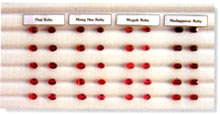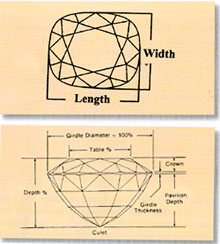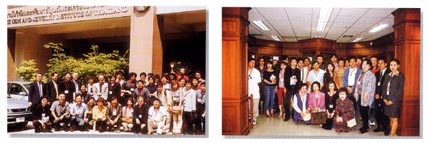
| |
 |
||||||||||||||
| |
|||||||||||||||
| |
|||||||||||||||
| |
|||||||||||||||
| |
|||||||||||||||
| |
|||||||||||||||
| |
|||||||||||||||
| |
|||||||||||||||
| |
|||||||||||||||
| |
|||||||||||||||
| |
|||||||||||||||
| |
|
|
|
|
|
|
|
|
|
|
|
|
|
|
|
| |
|
|
|
|
|
|
|
|
|
|
|
|
|
|
|
| Methods used for ruby grading and results | ||||||||||||||||||||||||||||||||||||||||||
In
general there are three factors governing the assessment of a ruby. It's
beauty, quality and value (natural or synthetic origin). (See a flowchart
showing criteria used to access a ruby's grading) |
||||||||||||||||||||||||||||||||||||||||||
 |
||||||||||||||||||||||||||||||||||||||||||
1.1 Beauty : this
is the most important easily seen aspect of a gemstone and a strong
factor in determining it's value. Beauty is a subjective word. It is
in fact, a collective term combining color, brilliance and transparency
when assessing a ruby or, for that matter any gemstone. |
||||||||||||||||||||||||||||||||||||||||||
 |
||||||||||||||||||||||||||||||||||||||||||
Three
criteria, attractive color, brilliance, and transparency were used by
the GIT to select eight sets of standard rubies weighing from 0.75 to
1 carats from four diiferent geographic regions. Included were two sets
of Thai, Mogok, Mong Hsu and Madagascar rubies. Each set has 5 tone levels
ranging from dark to light. |
||||||||||||||||||||||||||||||||||||||||||
 Plate 4 Two sets of Thai, Mogok, Mong Hsi and Madamesear rubies |
These
standard ruby sets were used to conduct the color preference survey. The
participants in this study were buyers and gemmologists from various countries
who attended the 28th Gem and Jewelry Fair in Bangkok between
the 13th and 16th of September, 2001. The participants
were divided into 6 groups and numbered by geographic origin, (Thais 191,
Americans 49, Europeans 76, Japaneses 55, Tndians 64, and other Asian
countries 47) The results of the Color Preference Survey are shown in
following tables. (Plate 5 - Plate 8) |
|||||||||||||||||||||||||||||||||||||||||
|
||||||||||||||||||||||||||||||||||||||||||
In
order to evaluate three of the important factors contributing to the beauty
of a ruby more precisely we used quantitative methods grouped under the
heading 'Quality'. 1.2 Quality - The quality of a riby is based on 4 independent criteria; color, clarity, cut grading and carat weight. 1.2.1 Color Grading The color of a ruby determines at least 50% of its final market value. The color grading of rubies is very difficult and more subjective than when grading diamonds. The GIT method has been designed to provide a meaningful grading system that is easily understood and used. This system can be directly related to market price. |
||||||||||||||||||||||||||||||||||||||||||
|
The color grading
of a ruby becomes complicated because we must consider three separate
components that are both independent and interrelated, namely hue, tone,
and saturation (color intensity). Hue describes the dominant and additional colors in a gemstone that are visible to the naked eye. In our example, a purplish/red (PR) ruby has red as the dominant color and purple as the secondary color. Value of Tone - This is the lightness or darkness of a color sensation. Saturation or Chroma is best described as the strength or intensity of the hue sensation. The GIT Color Grading System is based on the Munsell Color Chart. Each ruby was matched to the appropriate Munsell color chip and viewed under a standard 5,000 Degree Kelvin light source. (Plate 9,10). |
|||||||||||||||||||||||||||||||||||||||||
1.2.2
Clarity Grading Clarity is the second most important factor when evaluating rubies. The clarity of the stone is the second Each stone in the standard sets was assigned a Munsell color code and name. The results were compared with the ISCC-NBS of the ASTM color chart. Additionally the Munsell Color Code can be converted into the color coordinates of the L*U*V* and L*a*b* system. Most important factor when determining value and is worth between 20 and 30% in the grading system. The clarity of a ruby is first determined with naked eyes and then under 10x magnification. the clarity of a ruby can be determined by a point system that takes into account the following factors. Inclusions (including the location of inclusions in the ruby), number of inclusions, the size aggregation and contract of any inclusions. |
|||||||||||||||||||||||||||||||||||||||||||||||||||
| Table 1 : The point system for clarity grading of rubies | |||||||||||||||||||||||||||||||||||||||||||||||||||
|
|||||||||||||||||||||||||||||||||||||||||||||||||||
| Table 2 : Then the total score will be used to assign the final clarity grade | |||||||||||||||||||||||||||||||||||||||||||||||||||
|
|||||||||||||||||||||||||||||||||||||||||||||||||||
| Table 3-4 : Samples of clarity | |||||||||||||||||||||||||||||||||||||||||||||||||||
|
|||||||||||||||||||||||||||||||||||||||||||||||||||
Then, the totalscore will be used to assign the final clarity grade: < 9 Minute Inclusions (Mil) or Excellent Clarity 10-12 Minor inclusions (Mrl) or Fine Clarity 13-16 Noticeable Inclusion (NI) or Very Good Clarity 17-19 Moderate Inclusion (Mol) OR Fair Clarity Minute Inclusion (Mil): Visible with 10x magnification, very difficult to see with naked eyes. Minor Inclusion (Mrl): Visible with 10x magnification, difficult to see with naked eyes. Noticeable Inclusion (NI): Easily visible with 10x magnification, just able to see with naked eyes. Moderate Inclusion (Mol): Very easily seen with 10x magnification, easy to see with naked eyes. Significant Inclusion (SI): Very easily seen with 10x magnification, very easy to see with naked eyes. |
|||||||||||||||||||||||||||||||||||||||||||||||||||
| 1.2.3
Cut Grading Cutting is the third important factor when evaluating rubies. The cut component is worth 10% to 20% of the value in a grading system. Criteria for cut grading are the proportion and finish of a ruby. |
|||||||||||||||||||||||||||||||||||||||||||||||||||
| Proportion:
there are 3 criteria used to assess proportion 1-Face-up
balance
When viewed in the face-up position, the opposite parts of the faceted stone should be exactly the same size and well shaped. The overall effect should be appealing to our eyes. 2-Profile balance When viewed from the side of the table, the culet should be exactly centered, the girdle not wavy, and the pavillion bulge should be even. Total depth percentage (the height of a ruby measured from table to culet, divided by the width and multiplied by 100) should normally be between 60 and 65%. The crown height measuring from table to girdle should fall between 1/4 to 1/3 of the total depth. The pavillion depth measuring from girdle to culet should vary between 2/3 to 3/4 of the total depth. (Plate 12, 13, 14) 3-Brilliance The light returned to the eye is known as brilliance. As the brilliance |
 |
||||||||||||||||||||||||||||||||||||||||||||||||||
| increases rubies become more
valuable. When light leakage occurs it is known as windowing. When dark
areas are visible. It is know as extinction. Finish: There are three criteria used to assess finish 1-Polish:consider the surface characteristics 2-Symmetry: consider shape, position, and arrangement of facets 3-Facet survey: consider the number of facets. Facet positions |
Plate 12 and Plate 13 |
||||||||||||||||||||||||||||||||||||||||||||||||||
 |
|||||||||||||||||||||||||||||||||||||||||||||||||||
| should be suitable to the cutting style. | Plate 14 and Plate 15 |
||||||||||||||||||||||||||||||||||||||||||||||||||
1.2.4
Weight (in carats) will also determine the price of the stone. A Large-sized ruby should have a Higher price per carat than that of a smaller-sized ruby of the same quality. This is because the smaller stone is easier to find than the larger one. |
|||||||||||||||||||||||||||||||||||||||||||||||||||
 Plate 16 |
|||||||||||||||||||||||||||||||||||||||||||||||||||
|
Value The word 'value' in our context means its authenticity. A natural ruby without any treatment and originating from a world famous origin such as Mogok is considered, by the trade, to be a premium gemstone. Therefore, the first priority in the grading process must be to determine whether any forms of treatment or enhancement have been used. Only then can we logically proceed to the analysis of the gemstones color, clarity, cut, and weight (carats). |
|||||||||||||||||||||||||||||||||||||||||||||||||||
 |
|||||||||||||||||||||||||||||||||||||||||||||||||||
| The Ruby Grading
System was presented for the first time to 150 members of the Jewel Fest
Club and other invited traders at its Annual General Meeting at the Dusit
Thani Hotel on November 7, 2001 and to 300 TGJTA members and the exhibitors
of the Bangkok Gem and Jewelry Fair at the Napalai Ballroom of the Dusit
Thani Hotel on November 26, 2001. Presentations were also made to 130 Japanese
ruby Importers and retailers at the GIT on January 21 and February 6, 2002. The new ruby grading system was described in the GIT GEM IDENTIFICATION REPORT used to promote the sale of rubies in the Ruby Year 2002 in Japan. The GIT will be the main organiation to test and grade all the rubies to be exported to Japan during the Thai Ruby Year 2002. The GIT Gem Identification report is available in both full and pocket size versions signed by two gemmologists. With a picture of the stone and including details of colour, brilliance, transparency and cut. The certificate will also have a 3-D hologram picture of the Grand Palace, which is important to our heritage. The GIT is certain that issuing an internationally accepted certificate of ruby grading will help to boost Thailand's ruby exports. Thank to Mr. Philip L. Condax for his kind editiorial assistance in preparing various ruby grading system documents. |
|||||||||||||||||||||||||||||||||||||||||||||||||||
 |
|||||||||||||||||||||||||||||||||||||||||||||||||||
 |
|||||||||||||||||||||||||||||||||||||||||||||||||||
|
|||||||||||||||||||||||||||||||||||||||||||||||||||
C
o p y r i g h t © 2 0 0 0 - 2 0 1 6 D4U
WEB TM A l l R
i g h t s R e s e r v e d ABOUT
US | GUESTBOOK |
PROJECT
& DESIGN | QUICK
- FIND | OVERVIEW
| BOOKSEARCH | D4U
WEB |
|||||||||||||||||||||||||||||||||||||||||||||||||||